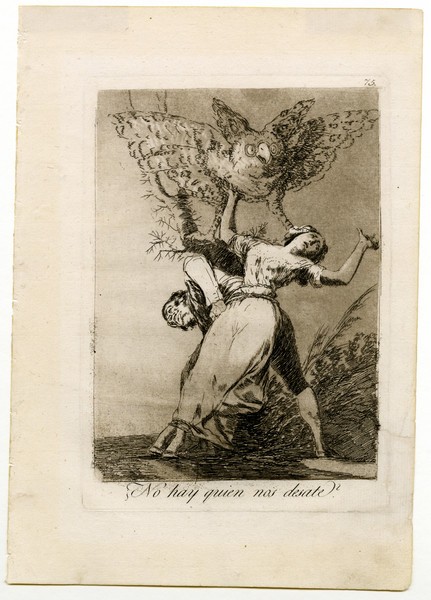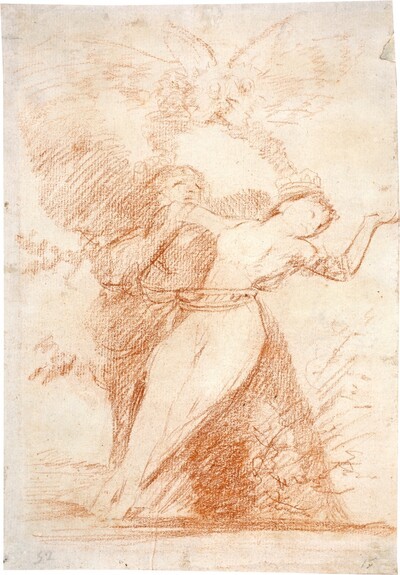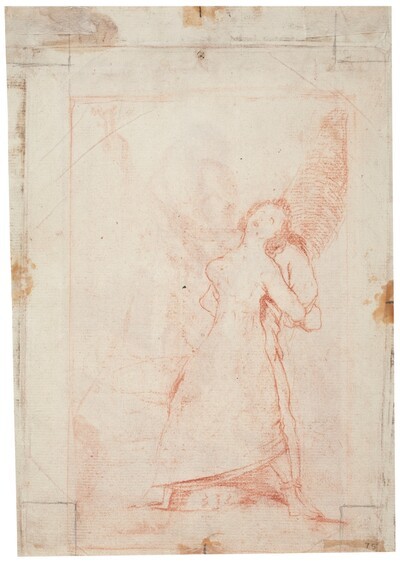- Cronología
- Ca. 1797 - 1799
- Dimensiones
- 218 x 152 mm
- Técnica y soporte
- Etching and burnished aquatint
- Reconocimiento de la autoría de Goya
- Undisputed work
- Ficha: realización/revisión
- 13 Jan 2011 / 29 May 2024
- Inventario
- 225
¿No hay quien nos desate? (at the bottom)
75. (in the upper right-hand corner)
There is only one known proof prior to the letter with burnished aquatint in the Rijksmuseum, Amsterdam. It has a handwritten title, No se puede desatar! which seems to have replaced an earlier erased one.
There are also other proofs in which the title ends in an exclamation mark instead of the question mark for which it will later be replaced.
Two preparatory drawings of this engraving (1) and (2) are preserved in the Prado Museum.
A man and a woman are tied at the waist to the trunk of a dry tree in the middle of a scrubby field. Both struggle to free themselves; the man makes violent efforts by leaning his torso forward and she, with her legs tied at the ankles, moves to the opposite side with her arms raised. Above them flies an enormous owl with a curved beak and eyes with its wings outstretched, resting one of its talons on the woman's face with an anguished gesture.
The artist has used a single aquatint that contrasts with the reserves of varnish with which he has created the whites that illuminate the couple. This contrast will gradually fade with each print run as the aquatint wears away, but the lines drawn with the etching remain intact. The burnisher is also used on the feathers of the owl and on the female figure to achieve half-tones.
The manuscript in the Prado Museum explains this engraving as follows: "A man and a woman tied with ropes and struggling to get free and shouting to be untied in haste? Either I am mistaken or they are two forcibly married".
In this print Goya has created an allegorical image of marriages of convenience, which were very common at the time, depicting the difficulty of breaking the bonds that united the spouses. The owl, a common figure in Goyaesque iconography, alludes to all those forces that hindered the dissolution of marital errors. In Spain at the time, divorce, which had been legalised in France after the French Revolution in 1792, began to be debated. In France, divorce could be granted under seven conditions and was considered a universal right for both men and women.
The theme of arranged and unhappy marriages was also dealt with in Caprice No. 14, What a Sacrifice! and in Folly No. 7, Disorderly Folly.
The plate is in poor condition (National Chalcography, no.246).
-
Goya. Das Zeitalter der Revolucionen. Kunst um 1800 (1980 – 1981)Hamburger KunsthalleHamburg1980cat. 41
-
Goya. La década de Los CaprichosMadrid1992organized by Real Academia de Bellas Artes de San Fernando sponsored by Fundación Central Hispano, Madrid, consultant editor Nigel Glendinnig. From October 26th 1992 to January 10th 1993cat. 24
-
Francisco de GoyaMuseo d'Arte ModernaLugano1996exhibition celebrated from September 22nd to November 17th.cat. 75, p.102
-
Francisco Goya. Sein leben im spiegel der graphik. Fuendetodos 1746-1828 Bordeaux. 1746-1996Galerie KornfeldBern1996from November 21st 1996 to January 1997cat. 81
-
Das Capriccio als KunstprinzipWallraf-Richartz-Museum,1996from December 8th 1996 to February 16th 1997, exhibited also in Zurich, Kunsthaus, from March 14th marzo 1997 to June 1st 1997 and in Vienna, Kunsthistorisches Museum mi Palais Harrach, from June 29th 1997 to September 21st 1997.cat. G35
-
Goya artista de su tiempo y Goya artista únicoThe National Museum of Western ArtTokyo1999from December 1st to July 3th 1999cat. 123
-
Francisco Goya. Capricci, follie e disastri della guerraSan Donato Milanese2000Opere grafiche della Fondazione Antonio Mazzottap.50, cat. 75
-
Goya. La imagen de la mujerMuseo Nacional del PradoMadrid2001from October 30th 2001 to February 10th 2002. Exhibitied also at the National Gallery of Art, Washington, March 10th to June 2nd 2002, consultant editor Francisco Calvo Serrallercat. 94
-
Goya e la tradizione italianaFondazione Magnani RoccaMamiano di Traversetolo (Parma)2006consultant editors Fred Licht and Simona Tosini Pizzetti. From September 9th to December 3th 2006cat. 75, p.164
-
Goya. Opera graficaPinacoteca del Castello di San GiorgioLegnano2006exhibition celebrated from December 16th 2006 to April 1st 2007p.43
-
Goya e ItaliaMuseo de ZaragozaZaragoza2008organized by the Fundación Goya en Aragóna, consultant editor Joan Sureda Pons. From June 1st to September 15th 2008cat. 346
-
Goya et la modernitéPinacothèque de ParisParís2013from October 11st 2013 to March 16th 2014cat. 138
-
Goya: Order and disorderMuseum of Fine ArtsBoston2014cat. 74
-
Hamburg2019cat. 102
-
2022
-
Goya engravings and lithographs, vol. I y II.OxfordBruno Cassirer1964p.153, cat. 110
-
Vie et ouvre de Francisco de GoyaParísOffice du livre1970p.184, cat. 602
-
Goya, la década de los caprichos: dibujos y aguafuertesMadridReal Academia de Bellas Artes de San Fernando1992pp.40-42, cat. 24-25
-
Catálogo de las estampas de Goya en la Biblioteca NacionalMadridMinisterio de Educación y Cultura, Biblioteca Nacional1996p.114, cat. 167
-
El libro de los caprichos: dos siglos de interpretaciones (1799-1999). Catálogo de los dibujos, pruebas de estado, láminas de cobre y estampas de la primera ediciónMadridMuseo Nacional del Prado1999pp.372-375
-
ParísPinacoteca de París2013p. 199
-
Goya: Order & DisorderBostonMuseum of Fine Arts Boston Publications2014p. 140
-
Goya. In the Norton Simon MuseumPasadenaNorton Simon Museum2016pp. 42-75
-
HamburgHirmer2019p. 311
-
Museo de Bellas Artes de Badajoz y Diputación de Badajoz2022p. 51


